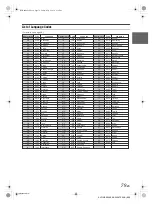
67
-EN
01GB06X009E.fm
ALPINE X009E 68-24567Z66-A (EN)
About the Rear Camera Guide
To display the guide, set “Guide Display ON/OFF Setting” (page 66) to
On. Also, to adjust the guide, refer to “Adjusting the Rear/Front Camera
Guide” (page 55). You can also turn off the guide in the Rear camera
display screen.
Indication mark meaning
When the car is put into reverse gear, the monitor switches to the rear
view camera image. Guides appear to help visualize the car’s width and
distance from the rear bumper.
1
Car width extension marks (red, yellow and green in
order of distance)
If properly calibrated, the marks indicate the car’s width.
This helps guide the car’s path when backing up in a
straight line.
The marks represent the distance from the rear of the car
(from the rear end of the bumper).
•
The marks do not move in synchronization with the
steering wheel.
2
Distance guidance marks
The marks represent the distance from the rear of the car
(from the rear end of the bumper).
•
The marks do not move in synchronization with the
steering wheel.
•
Each centre position of the mark represents about 0.5 m
(red), about 1 m (yellow) and about 2 m (green) behind.
• Depending on the condition of the car or road surface, the range of
vision may vary.
• The camera has a limited range of vision. Objects at extreme angles
to the camera (e.g. under the bumper or at opposite ends of the
bumper) may not be in the its field-of-vision.
• The rear camera image may have a tint which is different from the
actual surroundings.
• Depending on the car, the guidance may deviate to the right or left.
This is not a malfunction.
Distance guidance mark
The distance guides represent the ground level distance from the rear
bumper. It is difficult to accurately estimate the distance to objects
above ground level.
<Screen>
<Positions of A, B and C>
In the screen, according to the distance guidance marks,
the truck seems to be parked about 1 m away (at the
position B). In actual fact, however, if you reversed to
position A, you would collide with the truck.
In the screen, positions A, B and C seem to be located in
order of proximity. However, in actual fact, the position A
and C are the same distance, and B is farther away than
positions A and C.
• The car width extension mark represents the distance to the road
surface. The distance to an object on the road is not accurately
represented by the guides.
• In the following conditions, screen visibility may be impaired. This is
not a malfunction.
- When it is dark (during the night, etc.).
- Under very high or very low temperature conditions.
- When water drops adhere to the camera, or when the humidity
is high (such as rainy weather, etc.).
- When foreign bodies (such as mud, etc.) adhere to the camera
or its peripheral area.
- When sunlight or headlights directly strike the camera lens.
- When a CCD camera is connected, smearing* may occur. This
phenomenon is peculiar to CCD cameras.
* Smear phenomenon:
A phenomenon which occurs when a high-intensity spot (such
as a reflection of the sunlight on a car body) is shot by the
camera. The picture below is an example of ’vertical smear’
common to CCD cameras.
C
B
A (about 0.5 m)
about 1 m
A high-intensity spot
01GB00X009E.book Page 67 Friday, May 9, 2014 1:16 PM
















































